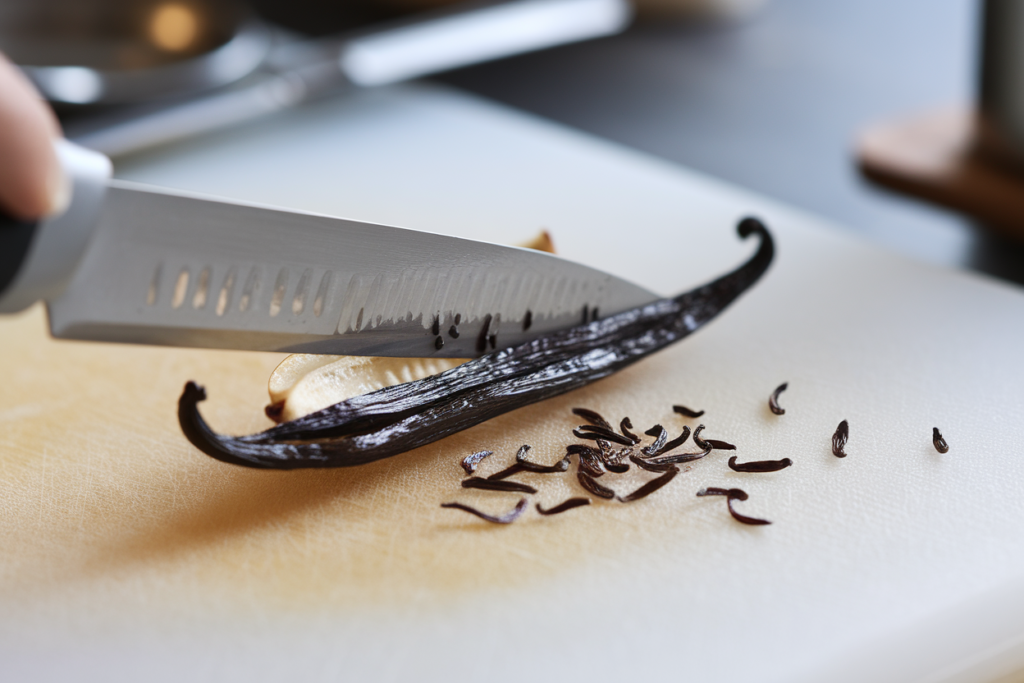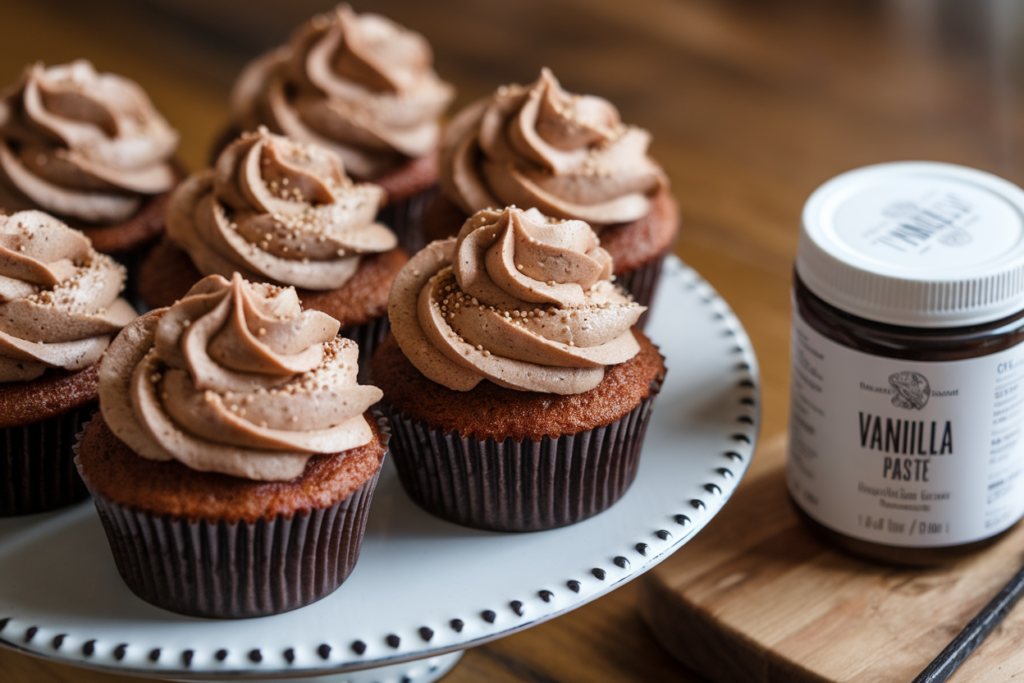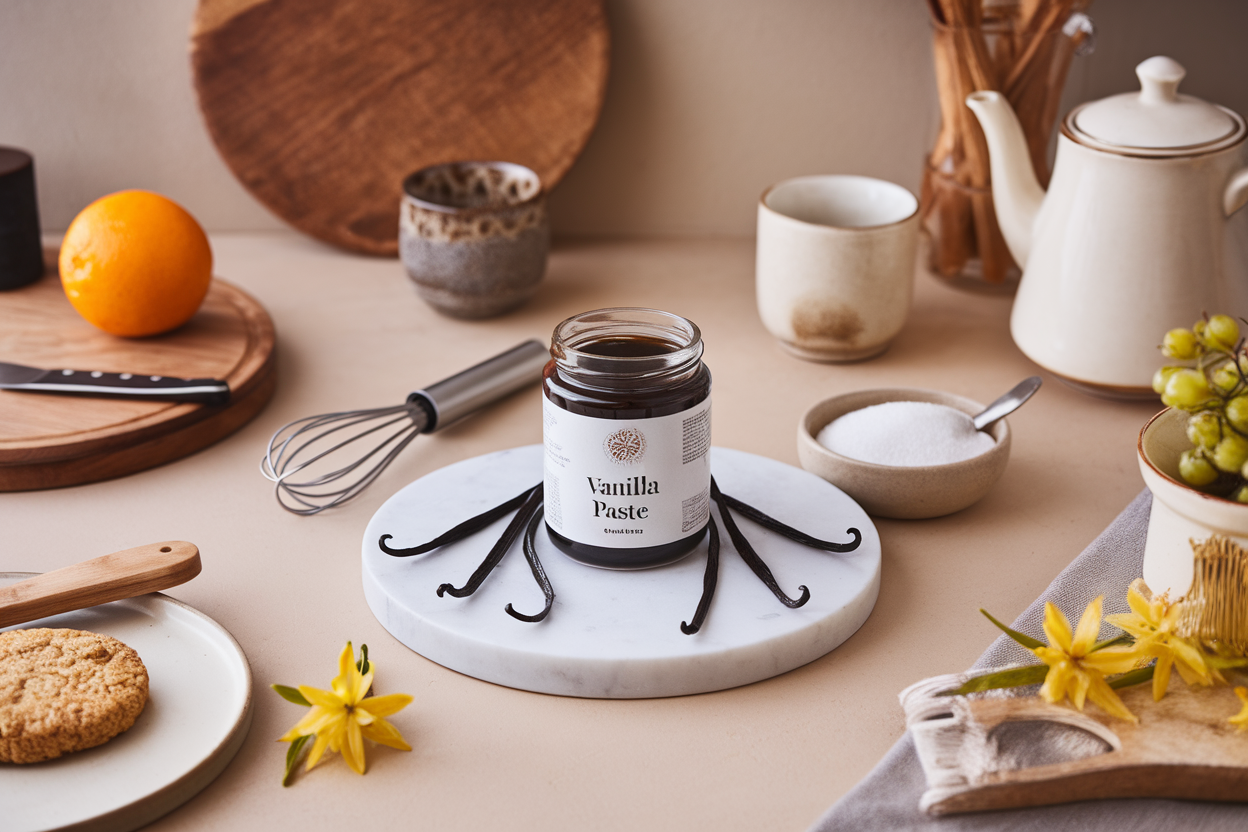Vanilla paste—you’ve probably seen it popping up in recipes and wondered, what exactly is it? Whether you’re an amateur baker or a seasoned chef, understanding this magical ingredient can transform your culinary game. Today, let’s dive deep into the fascinating world of vanilla paste and discover how it’s made. Buckle up; it’s going to be a flavorful ride! 🌟
Introduction to Vanilla Paste
What Is It?

This versatile vanilla product is a rich, syrupy blend of vanilla bean seeds, extract, and a thickening agent like sugar or gum. It bridges the gap between convenience and gourmet appeal, delivering both intense flavor and an elegant, speckled appearance.
Think of it as the secret weapon for bakers and chefs who want high-quality results without the hassle of scraping seeds from vanilla pods. This ingredient transforms ordinary dishes into extraordinary creations with ease.
Why Is It So Popular?
This flavorful blend is beloved for its versatility and concentrated taste. Whether you’re making cakes, custards, or even coffee, it enhances recipes with just a small amount. It’s the perfect choice for anyone aiming to create dishes that look as professional as they taste.
Its defining feature? Those beautiful black specks of vanilla seeds that elevate the appearance of any dish. They add a visual and aromatic charm, making it a favorite in kitchens everywhere.
What makes it even better? Those delightful little black specks of vanilla seeds that instantly make any dish look more appealing. They’re like edible confetti, turning ordinary desserts into visual masterpieces. No wonder vanilla paste has become a kitchen essential for professionals and hobbyists alike.
The History of This Versatile Ingredient
Origins of Vanilla as a Flavor
Vanilla, originally sourced from the orchids of Mexico, was cherished by the Aztecs and used to flavor cacao-based drinks. Over time, it became a sought-after ingredient in European kitchens.
Evolution of Extracts and Related Products
The convenience of liquid extract revolutionized cooking, but the desire for a product combining flavor with visual appeal led to the creation of this rich vanilla blend. Today, it’s a staple in both home and professional kitchens.
Ingredients That Make It Special
Core Components
This ingredient is crafted with:
- Vanilla Bean Seeds: Provide both flavor and a speckled aesthetic.
- Vanilla Extract: Deepens the taste.
- Sugar or Sweetener: Adds thickness and preserves freshness.
- Gum (e.g., Xanthan): Ensures a smooth, gel-like consistency.
Comparison to Other Options
- Vanilla Beans: Authentic but expensive and labor-intensive.
- Vanilla Extract: Convenient but lacks the visual elegance.
- This Blend: Offers the best of both worlds—intense flavor and aesthetic charm.
Comparing Vanilla Paste to Other Vanilla Products
Not sure how it stacks up? Here’s a quick breakdown:
- Vanilla Beans: Authentic but pricey and time-consuming.
- Vanilla Extract: Convenient but lacks the visual pop of seeds.
- Vanilla Paste: A perfect middle ground with both flavor and flair. 🌟
The Step-by-Step Process of Making Vanilla Paste
Sourcing High-Quality Vanilla Beans
The journey begins with the beans. Only top-notch beans—plump, fragrant, and moist—make the cut. Madagascar and Tahitian vanilla are the gold standards. 🌍
Extracting Vanilla Essence
Once the beans are selected, they’re split open to reveal the tiny seeds inside. The beans are then steeped in alcohol to extract their full-bodied flavor. Think of it like brewing the perfect cup of tea, but way fancier.
Creating the Paste Texture
To get that silky consistency, a binding agent like xanthan gum or sugar is added. This step ensures the paste spreads evenly and clings beautifully to whatever you’re baking.
Combining Ingredients for Optimal Flavor
Finally, the vanilla extract, seeds, and thickening agent are blended together in precise proportions. The result? A luscious paste bursting with flavor and dotted with those iconic specks. 😍
Common Challenges in homemade vanilla paste Production
Maintaining Consistent Flavor Profiles
One of the trickiest parts of making vanilla paste is keeping the flavor consistent. Natural vanilla beans vary in flavor depending on where they’re grown, which can be a bit of a wild card. Producers often blend beans from different regions to balance the taste.
Ensuring Sustainability in Vanilla Sourcing
Did you know that vanilla is one of the most labor-intensive crops to produce? Farmers must hand-pollinate each orchid, and the beans take months to cure. Sustainable practices are essential to protect the environment and support local farmers. 🌱
Avoiding Artificial Additives
Some commercial brands cut corners by adding synthetic flavors or fillers to their paste. While this might reduce costs, it also compromises the quality. Always check the label to make sure you’re getting the real deal!
“Good vanilla paste is like fine wine—worth the investment for quality.”
DIY Version
Ingredients
To make your own gourmet vanilla blend, you’ll need:
- Vanilla beans (10-12)
- Vanilla extract (1 cup)
- Sugar or sweetener (2-3 tablespoons)
- Xanthan gum (optional, ½ teaspoon)
Steps to Create Your Blend
- Split the beans and scrape out the seeds.
- Blend the seeds, extract, sugar, and xanthan gum until smooth.
- Store in an airtight jar in a cool, dark place.
A Simple Homemade vanilla bean paste creation Recipe
- Split the Beans: Use a sharp knife to slice each vanilla bean lengthwise and scrape out the seeds.
- Blend the Ingredients: Combine the seeds, vanilla extract, sugar, and xanthan gum in a blender until smooth.
- Store: Pour the paste into a sterilized jar and seal tightly. Store in a cool, dark place.
Tips for Storing and Using Homemade vanilla bean paste creation
- Keep it in an airtight container to preserve its freshness.
- Use within 6-8 months for the best flavor.
- A teaspoon of paste is equivalent to one vanilla bean or one teaspoon of extract. Handy, huh? 😊
The Benefits of Using vanilla bean paste creation

Enhanced Flavor Versatility
Vanilla paste is a flavor powerhouse! Its concentrated taste means you don’t need much to elevate your dishes. Whether it’s cookies, custards, or even coffee, a tiny bit goes a long way. Plus, those little specks of vanilla bean add a touch of elegance to anything you’re serving.
Better Appearance in Dishes
Ever notice how desserts with vanilla paste just look better? Those visible black seeds give your creations a fancy, gourmet vibe. It’s like dressing your food in its Sunday best. 🎩
Common Questions
How long does it last?
Stored properly, it can last up to two years.
How does it differ from extract?
This blend includes visible seeds and has a thicker, syrupy consistency.
Can I substitute it in recipes?
Yes, a teaspoon of this blend equals one vanilla bean or a teaspoon of extract.
Issues with Consistency
Sometimes, vanilla paste can be a bit too thick or too runny. If it’s too thick, try warming it slightly or adding a few drops of vanilla extract. Too runny? Mix in a pinch of xanthan gum and stir well.
Adjusting Flavor Intensity
Finding the flavor too strong? Use a little less than the recipe calls for. Not strong enough? Add an extra dab. Vanilla paste is forgiving, so feel free to experiment!
Storage and Shelf-Life Concerns
Vanilla paste lasts a long time, but improper storage can spoil it. Always keep it in a cool, dark place, and ensure the lid is tightly sealed. If you notice any odd smells or discoloration, it’s time to toss it.
Frequently Asked Questions (FAQs)
What Is the Difference Between Vanilla Extract and Vanilla Paste?
Vanilla extract is a liquid made by steeping vanilla beans in alcohol, while vanilla paste includes the seeds and has a thicker, syrup-like consistency. Paste gives you both flavor and visual appeal.
How Long Does Vanilla Paste Last?
Properly stored, vanilla paste can last up to two years. Keep it in a cool, dark place and tightly sealed.
Can I Substitute Vanilla Paste for Vanilla Extract in Recipes?
Absolutely! Use an equal amount of paste as you would extract. Bonus: your dishes will have those pretty vanilla bean specks.
Are There Any Allergens in Vanilla Paste?
Most vanilla paste is allergen-free, but always check the label for added ingredients or potential cross-contamination.
What Are the Best Vanilla Beans for Making Paste?
Madagascar vanilla beans are the most popular, but Tahitian and Mexican beans are excellent alternatives for unique flavors.
Is Vanilla Paste Suitable for Vegan and Gluten-Free Diets?
Yes! Most vanilla pastes are vegan and gluten-free. Just ensure there are no added animal-based thickeners or gluten-containing ingredients.
How Do I Store Vanilla Paste Properly?
To maintain its freshness, store vanilla paste in a cool, dark place like a pantry. Avoid exposing it to direct sunlight or excessive heat, which can degrade its quality over time.
Can I Use it in Savory Dishes?
Definitely! Vanilla paste adds a subtle sweetness that pairs well with seafood, pork, or even salad dressings. Experiment to find your favorite combinations.
How Does Vanilla Paste Compare in Cost to Other Vanilla Products?
While vanilla paste might seem pricier upfront, its concentrated flavor means you’ll use less per recipe. This makes it an economical choice in the long run.
Can I Make it at Home?
Absolutely! With a few ingredients like vanilla beans, vanilla extract, and a sweetener, you can whip up your own paste. Check out the DIY section of this guide for step-by-step instructions.
Why Does My Vanilla Paste Have a Slightly Different Color or Consistency?
Natural variations in vanilla beans can cause slight differences in color and consistency. This is a sign you’re using a high-quality, natural product!
Understanding the versatility of vanilla paste opens doors to experimenting with numerous recipes. For example, you can explore creative ways to incorporate it into desserts by visiting Vanilla Paste: Your Complete Guide to Flavorful Recipes. If you’re interested in crafting sweet treats with alternative ingredients, consider pairing this ingredient with options mentioned in Are Banana Bread Muffins Gluten-Free? A Complete Guide. Additionally, those curious about unique substitutions might find inspiration in articles like What Can You Substitute Cream Cheese For in Buffalo Chicken Dip?.
Conclusion
Vanilla paste isn’t just an ingredient; it’s a culinary secret weapon. Whether you’re baking cookies, whipping up ice cream, or crafting the perfect latte, it adds unparalleled flavor and a touch of elegance. Its versatility and aesthetic appeal make it a favorite for professional chefs and home bakers alike. With just a teaspoon, you can elevate any dish into something truly extraordinary.
If you’ve never tried it, now’s the time to dive in and see the difference for yourself. Trust us, your taste buds will thank you. From enhancing flavors to creating that Instagram-worthy dessert finish, vanilla paste truly is the unsung hero of the kitchen. 🌟

